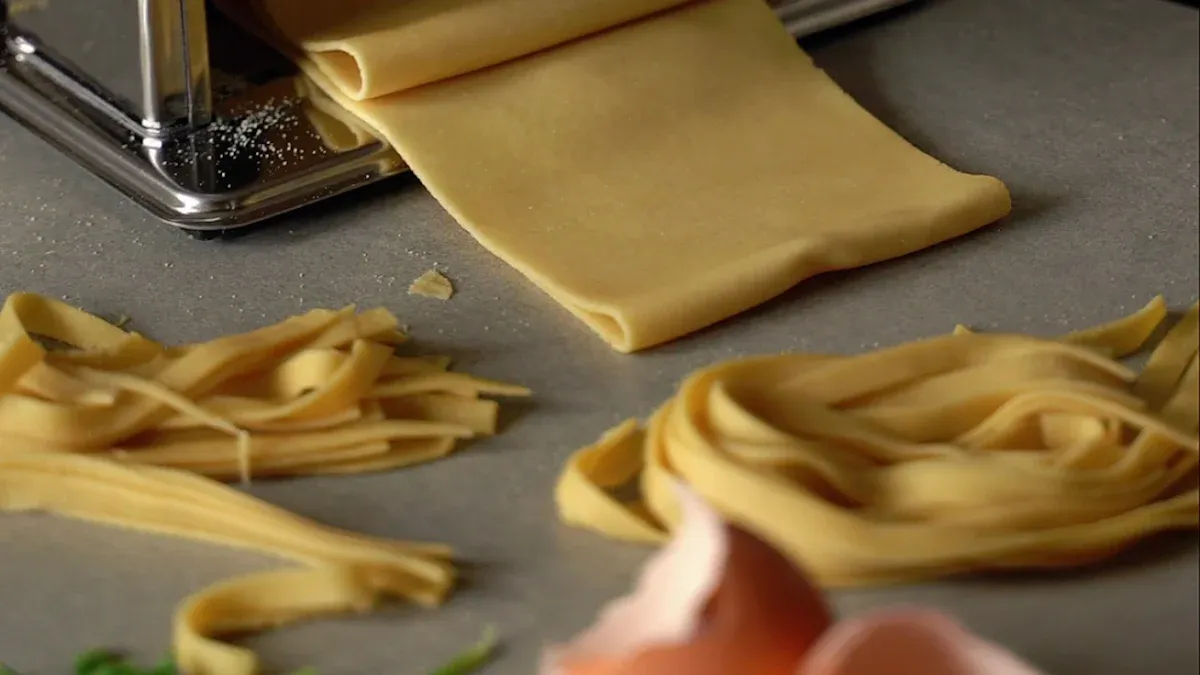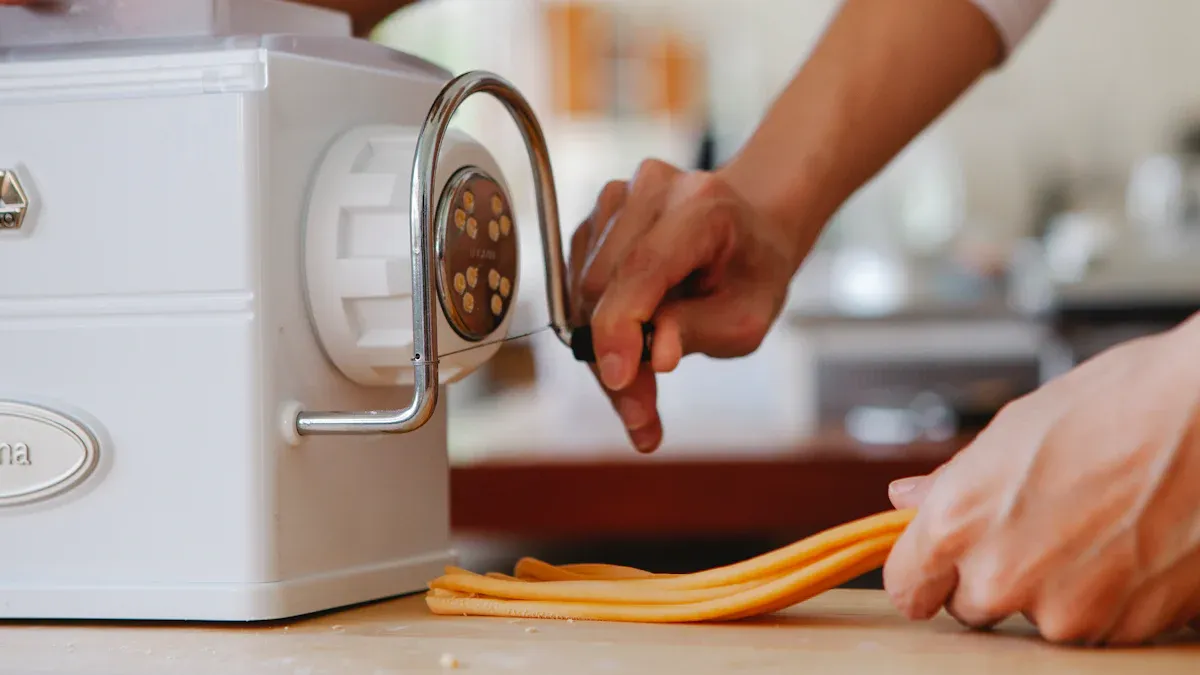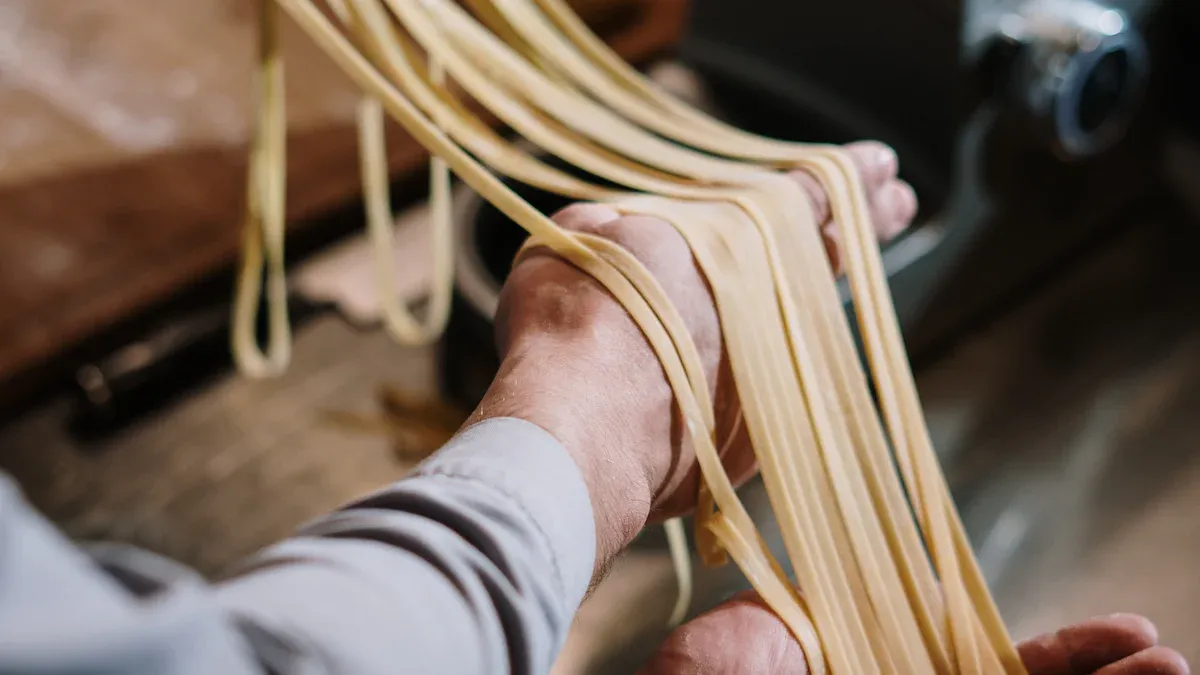© 2017-2018 Shangbaotai Machine Technology (Kunshan) Co., Ltd. All rights reserved. Site Map

The fresh noodles production line is revolutionizing the way noodles are made. These advanced machines utilize automation to operate more quickly and consistently, producing 30% more noodles than traditional hand methods. Companies benefit from reduced labor costs while increasing their output, allowing them to recoup the investment in the machinery within 2-3 years.
Shangbaotai Machine Technology's fresh noodles production line represents a significant advancement in noodle manufacturing. It incorporates innovative features such as vacuum dough mixing, which enhances the flavor and texture of the noodles. Additionally, the machines are customizable to produce various types of noodles, enabling businesses to easily meet diverse customer preferences.
The fresh noodle machine makes 30% more noodles faster, saving money.
Mixing dough in a vacuum improves noodle taste and texture, making them better.
Machines let one or two people run everything, cutting errors and costs.
Gentle steam cooking keeps noodles healthy, fresh, and not overcooked.
Businesses can adjust settings to make different noodles for all tastes.
Vacuum dough mixing is a big improvement for noodle making. This method takes out air while mixing the dough. It makes the dough denser and more even. This process improves the texture and stretchiness of noodles. The noodles become tastier and more fun to eat. Vacuum mixing also helps noodles keep their shape during cooking and packing.
This technology shows clear benefits in noodle quality. It makes the dough structure tighter and improves noodle performance. These features make it a key tool for modern noodle production.
Performance Metric | Description |
|---|---|
Mixing Performance | Better mixing and tighter dough structure. |
Dough Rheology | Improved dough handling during the mixing process. |
Noodle Quality | Higher noodle quality with vacuum mixing methods. |
Advanced sheeting and rolling systems make thin, even dough sheets. This step ensures noodles have the same thickness and texture. These systems also cut down on waste and improve efficiency. They fix any problems in the dough, giving great results every time.
These systems use smart tools to check and fix issues. For example, they find defects and remove bad parts of the dough. This keeps waste low and quality high. Such precision is important for large-scale noodle production.
Measurement/Index | Description |
|---|---|
Distortion Measurement | Finds sheet problems and spots defects. |
Cross Saw Integration | Cuts out bad parts to reduce waste. |
Illumination System | Uses light systems to find and fix defects. |
High-speed cutting tools are key for shaping noodles. These machines cut dough into exact shapes very quickly. They help make more noodles faster while keeping them uniform. This ensures every batch looks and tastes the same.
The tools are made from strong materials for better performance. For instance, tungsten carbide tools handle heat and cut faster. These features lower costs and keep noodle quality high.
Cutting Speed (sfm) | Tool Material | Benefits |
|---|---|---|
15,000 or greater | Tungsten carbide | Handles fast cutting speeds. |
Up to 4000 | Silicon nitride, ceramics | Works well under high heat. |
Above 4000 | Polycrystalline diamond, CBN | Handles heat and cuts quickly. |
Improves speed and lowers costs. | ||
Keeps noodles precise and high-quality. |
Automation is very important in making noodles today. The light-electric control system helps make work easier and faster. It uses smart sensors and electrical parts to watch and manage the whole process. This system keeps everything accurate, from mixing dough to packing noodles.
A big advantage is needing fewer workers. Just one or two people can run the whole line. This saves money and reduces mistakes. The system is simple to use, letting you change settings easily. It makes sure every batch turns out the same.
Tip: Automation doesn’t just save time. It also keeps noodle quality consistent.
The system also makes production safer. It spots problems and stops the machine to avoid accidents. This keeps the process smooth and safe, giving you confidence.
Cooking noodles well without ruining them is very important. The Fresh Noodle Production Line uses low-pressure steam to cook noodles evenly. This method avoids overcooking and keeps the noodles’ texture perfect.
Low-pressure steam cooking has many benefits. It uses less energy, making it better for the environment. It also keeps the noodles’ natural taste and nutrients. Every batch comes out cooked just right with the same texture.
Feature | Benefit |
|---|---|
Even Heat Distribution | Stops overcooking or undercooking |
Energy Efficiency | Saves money on energy |
Nutrient Preservation | Keeps noodles healthy and tasty |
This cooking method also makes noodles safer to eat. The steam kills harmful germs, keeping noodles clean and safe. With this technology, you can make noodles that are both yummy and safe for everyone.

The first step is getting the ingredients ready and mixing them. Measure the flour, water, and extras like salt or eggs. Use the right amounts to make good dough. The dough needs the right texture and stretchiness. The Fresh Noodle Production Line makes this easier with vacuum dough mixing. This method removes air, making the dough dense and smooth. This helps noodles stay firm and have a better texture when cooked.
Tip: Check the dough’s water level. Keep it between 28% and 35% for the best results.
After mixing, the dough is rolled into thin sheets. Advanced machines make sure the sheets are even and smooth. You can pick how thick you want the sheets, from 0.5 mm to 2.5 mm. The machines also check the quality of each sheet. This ensures every sheet meets the needed standards.
Measurement Type | Details |
|---|---|
Thickness Variability | Choose thickness from 0.5 mm to 2.5 mm |
Hydration Levels | Best moisture is between 28% and 35% |
Quality Control Measures | Machines monitor and adjust for quality |
This step ensures the noodle sheets are even and look the same. Consistency is key for making high-quality noodles.
The last step is cutting and shaping the noodles. High-speed tools cut the sheets into even strands. These tools use lasers for precise cutting, reducing waste. The cutting size can be as small as one micrometer or up to 100 micrometers. The system also keeps the temperature steady within ±0.5°C. This helps the noodles keep their shape and quality.
Lasers cut noodles with great accuracy.
Cutting sizes range from one micrometer to 100 micrometers.
Temperature stays steady within ±0.5°C for uniform noodles.
At the end of this step, the noodles are ready to be cooked or packed.
Cooking, cooling, and packaging are the last steps. These steps make sure noodles are safe, fresh, and tasty.
Low-pressure steam cooks noodles evenly and gently. This keeps their texture and flavor just right. The steam stops overcooking or undercooking. It also helps keep the noodles’ natural taste and nutrients.
Tip: Watch the cooking time carefully. Overcooked noodles get mushy. Undercooked noodles stay too firm.
After cooking, noodles are cooled quickly. This stops cooking and keeps them fresh. Chilled water or air cools the noodles fast. This step stops bacteria from growing and keeps noodles safe.
Cooling Method | Benefit |
|---|---|
Chilled Water Cooling | Quickly lowers noodle temperature |
Air Cooling | Keeps noodles’ texture perfect |
Once cooled, noodles are packed securely. You can pick different package sizes, like single or bulk packs. The machine seals the noodles tightly to keep them fresh longer.
Note: Good packaging keeps noodles safe and looks good for buyers.
By doing these steps, you can make noodles that people will love.
The Fresh Noodle Production Line helps make more noodles faster. It uses machines to remove delays and keep work flowing smoothly. Tools like Value Stream Mapping show how materials move, cutting down on waste. The 5S Method keeps the workspace neat, making work quicker and easier.
Automation can make 30% more noodles than older methods. Companies using lean ideas save 25% on costs and make more noodles. For example, Noodle Guru added machines and saved money on workers. Noodle Nirvana improved noodle quality and worked faster by using smart systems.
You can also make 25-30% more noodles with the same tools. This means you don’t need to buy extra machines. By fixing delays, the system helps you make enough noodles for more customers.
Using machines in noodle making saves a lot of money. You need fewer workers, so labor costs go down. For example, the Fresh Noodle Production Line needs only 1-2 people to run it. This setup makes fewer mistakes and costs less to operate.
Studies say machines can lower costs by 30%. Big companies like Tesla and Amazon use machines to save money. The Fresh Noodle Production Line works the same way, helping noodle makers save money. It also makes noodles better and keeps them the same every time.
Source | Evidence | Description |
|---|---|---|
McKinsey Study | Machines can lower costs by 30% | Shows how much money you can save. |
Keeping noodles clean and safe is very important. The Fresh Noodle Production Line uses smart tools to stay clean at every step. Machines reduce touching, so there’s less chance of germs. Low-pressure steam cooking keeps noodles tasty and kills bad bacteria.
Fast cooling, like using cold water or air, keeps noodles fresh. These methods stop germs from growing. Tight packaging keeps noodles safe from dirt. With this system, you can make noodles that are clean, safe, and high-quality for your customers.
Making noodles in large amounts needs consistency. The Fresh Noodle Production Line ensures every batch is the same high quality. It uses smart technology and strict checks to keep noodles uniform. You can trust this system to make noodles with the same taste, texture, and look every time.
The process has three main steps to keep quality steady:
Stage | Description |
|---|---|
Process Design | The process is planned using science. Important steps and quality checks are set to ensure good results. |
Process Qualification | The planned process is tested in real conditions to confirm it works well. |
Continued Process Verification | The process is watched all the time to fix any problems that might affect quality. |
These steps make sure every batch of noodles is just as good as the last one. With this system, you can always meet what customers expect.
Tip: Keep checking and adjusting the process to maintain top quality for all batches.
Different markets need different kinds of noodles. The Fresh Noodle Production Line lets you make many types, like hot-dry or cold noodles. This flexibility helps you match customer tastes and market trends.
Several things make this possible:
Factor | Description |
|---|---|
Regional Dietary Preferences | Different places have unique food habits needing special noodle types. |
Technological Advancements | New machines allow better control of noodle thickness and moisture. |
Consumer Trends | Flavors and colors can be changed to match local preferences, including healthier options. |
Production Methods | Cooking methods, like steaming, can be adjusted to meet regional needs. |
This flexibility helps you make noodles for all kinds of customers. Whether for health-focused buyers or traditional markets, the system adjusts to your needs.
Note: Customizing noodles not only meets customer demands but also helps you stay ahead in the noodle business.

AI and IoT are making noodle production smarter and faster. AI tools study past and current data to improve factory work. They help predict problems and avoid delays. IoT sensors check machines in real time, keeping everything running smoothly.
These tools also track inventory automatically, reducing mistakes. By linking IoT with tools like Power BI, you get better planning insights. AI-powered maintenance predicts machine needs, stopping sudden breakdowns. These technologies save time and match today’s need for smart systems.
Sustainability is now key in noodle production. Using energy-saving machines and green packaging attracts eco-friendly buyers. Buying local ingredients helps the economy and keeps products fresh. Seasonal items cut waste and improve quality. These steps can lower costs by 30%, says the Food and Agriculture Organization.
Being eco-friendly also increases profits. Studies show companies with green strategies can boost profits by 5%. Focusing on sustainability cuts costs and meets customer demand for eco-friendly products.
Catering to niche markets is important today. Customizing noodles for specific tastes, like regional or healthy options, is key. Big companies like Amazon use customer data to offer personalized choices, building loyalty.
Market research helps find niche groups and adjust products for them. For example, changing noodle thickness or flavors can attract unique customers. This strategy strengthens your brand and keeps you ahead of changing trends.
Keeping fresh noodles good for longer is very important. New technologies help noodles stay fresh without losing taste or texture. These methods make sure noodles are safe and enjoyable for customers.
One big improvement is better packaging materials. Vacuum-sealed bags and modified atmosphere packaging (MAP) are common. These methods take out oxygen or add gases like nitrogen. This slows down spoilage, keeping noodles fresh for weeks instead of just days.
Another helpful method is better preservation techniques. Storing noodles at low temperatures with antimicrobial treatments stops bacteria. This keeps noodles safe to eat and tasting great. For example, natural preservatives like vinegar or citric acid can keep noodles fresh without changing their flavor.
Using data is also important for shelf life. Stability tests show how long noodles stay fresh. The International Council for Harmonisation (ICH) gives rules for checking this data. By following these rules, you can set correct expiration dates for noodles.
Tip: Test your noodles often in different conditions to keep quality steady.
These new ideas help noodles last longer, cut down on waste, and make customers happy. Using these technologies helps you deliver fresh, high-quality noodles and stay ahead in the market.
The Fresh Noodle Production Line from Shangbaotai Machine Technology changes noodle-making. It uses smart automation and features like vacuum dough mixing. The machines can be adjusted to make different noodle types. This helps save money on workers and meet customer needs easily.
Pro Tip: Use new tech like AI and IoT to improve. These tools keep quality high and help you follow industry changes.
This system sets a new standard, helping you improve how noodles are made.
This machine can make many noodles like hot-dry, lor mee, and cold noodles. You can adjust it to fit local tastes or market needs, making it very flexible.
Only 1 or 2 people are needed to run the system. The smart control system makes it easy to use, cutting labor costs and reducing mistakes.
Yes, you can change things like roller sizes, packaging styles, and noodle types. This lets you set it up for your specific production needs.
The machine can make up to 1000 kilograms of noodles every hour. This makes it great for both small and big businesses.
Vacuum dough mixing takes out air, making the dough smooth and dense. This improves the noodles’ stretchiness, taste, and shape during cooking and packing.